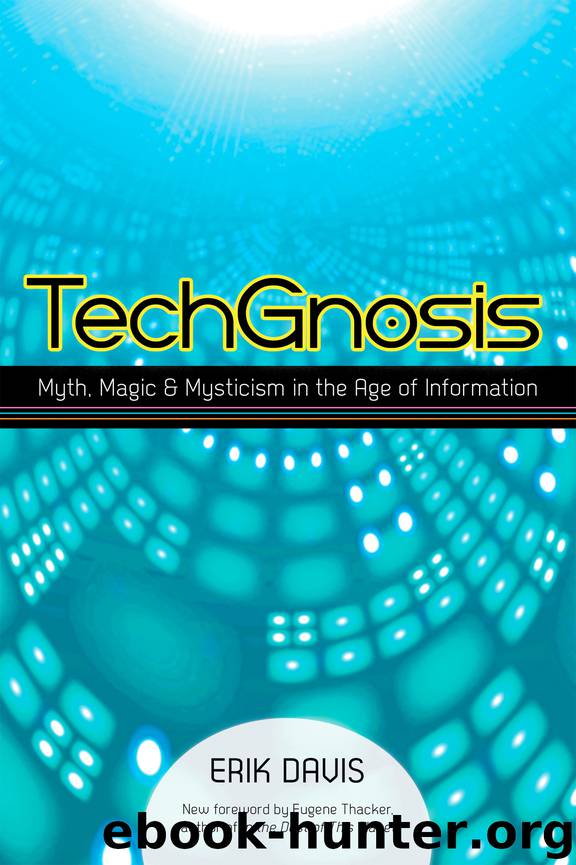TechGnosis by Erik Davis

Author:Erik Davis [Davis, Erik]
Language: eng
Format: epub
ISBN: 978-1-58394-931-3
Publisher: North Atlantic Books
Published: 2015-03-17T04:00:00+00:00
VII
Cyberspace: The Virtual Craft
Like Trojan horses, buzzwords carry their own secret contents, hidden histories and meanings that many of their users hardly suspect. Many people first heard the term virtual reality in the beginning of the 1990s, when a large and very clever dreadlocked gearhead named Jaron Lanier started showing off various goggles and gloves capable of launching the mind into three-dimensional worlds made of computer graphics. Hitting the mass brainstem like a rush of crack, the term rapidly took on the millennialist charge of all pop futurisms. Though the hype died down when the technology failed to deliver digital dreamtime, virtual reality remains a fundamental raison d’être of computer culture, a holy grail that keeps beckoning through the forest of tangled protocols and clunky hardware.
But virtual reality was not hatched in the hopped-up halls of Silicon Valley. Back in 1938, the French playwright, film actor, and state-declared madman Antonin Artaud dropped the phrase in one of the blazing manifestos collected in his magnum opus, The Theater and Its Double. Discussing the “mysterious identity of essence between alchemy and the theater,” Artaud argued that the theater creates a virtual reality—“la réalité virtuelle”—in which characters, objects, and images take on the phantasmagoric force of alchemy’s visionary internal dramas. For Artaud, theater is no more about representing ordinary life than alchemy is about the chemical transmutation of lead into gold. Instead, both of these symbolic rituals should catalyze the same psychological states once produced in the “archetypal, primitive theater” of the Eleusinian Mysteries and the shamanic Orphic cults of ancient Greece. Artaud argued that, at their essential core, these ancient ritual spectacles evoked “the passionate and decisive transfusion of matter by mind”—the ultimate gnostic transmutation of reality that alchemists symbolized with the fabled philosopher’s stone.
Artaud wrote that the image of this spiritualized state of matter beckons to us from “the incandescent edges of the future,” and that it is this brass ring that powerful art and theater are constantly striving to hook. But today it is technology that restlessly plunges toward the incandescent edge of the future. As we’ll see in this chapter, the techgnostic drive does not aim solely for the disembodied cognitive augmentation of the Extropians; it also sets its sights on a more hermetic world of magical iconography, mythic masks, and otherworldly journeys. The VR gear trumpeted by Lanier provided one snapshot of such an alchemical realm, but the astral plane of technoculture had already made its appearance in, of all places, a science-fiction novel.
Written on a Hermes 2000 manual typewriter and published in the prophetic year of 1984, William Gibson’s Neuromancer hit the cultural cortex around the same time that personal computers invaded the home, and world financial markets launched into twenty-four-hour orbit. Though both Hollywood and recent history have made Gibson’s dystopian vision of gritty data-hustlers, cutthroat corporations, and pervasive brand names as clichéd as the trench coats and femmes fatales of the noir thrillers that Gibson drew from, the novel’s continued relevance (and resonance) can be boiled down to one single, almost religiously cited image: “Cyberspace.
Download
This site does not store any files on its server. We only index and link to content provided by other sites. Please contact the content providers to delete copyright contents if any and email us, we'll remove relevant links or contents immediately.
| Automotive | Engineering |
| Transportation |
Whiskies Galore by Ian Buxton(41710)
Introduction to Aircraft Design (Cambridge Aerospace Series) by John P. Fielding(33011)
Small Unmanned Fixed-wing Aircraft Design by Andrew J. Keane Andras Sobester James P. Scanlan & András Sóbester & James P. Scanlan(32678)
Craft Beer for the Homebrewer by Michael Agnew(18072)
Turbulence by E. J. Noyes(7888)
The Complete Stick Figure Physics Tutorials by Allen Sarah(7257)
Kaplan MCAT General Chemistry Review by Kaplan(6811)
The Thirst by Nesbo Jo(6748)
Bad Blood by John Carreyrou(6468)
Modelling of Convective Heat and Mass Transfer in Rotating Flows by Igor V. Shevchuk(6349)
Learning SQL by Alan Beaulieu(6152)
Weapons of Math Destruction by Cathy O'Neil(6075)
Man-made Catastrophes and Risk Information Concealment by Dmitry Chernov & Didier Sornette(5866)
Digital Minimalism by Cal Newport;(5576)
Life 3.0: Being Human in the Age of Artificial Intelligence by Tegmark Max(5395)
iGen by Jean M. Twenge(5294)
Secrets of Antigravity Propulsion: Tesla, UFOs, and Classified Aerospace Technology by Ph.D. Paul A. Laviolette(5231)
Design of Trajectory Optimization Approach for Space Maneuver Vehicle Skip Entry Problems by Runqi Chai & Al Savvaris & Antonios Tsourdos & Senchun Chai(4949)
Electronic Devices & Circuits by Jacob Millman & Christos C. Halkias(4859)
